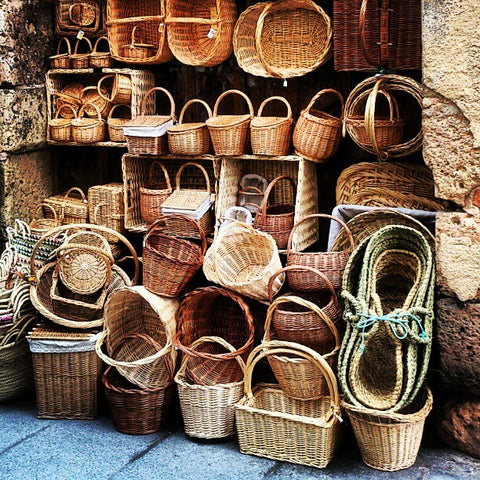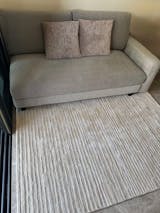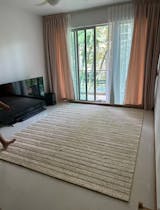
Look at the objects around you. Observe what they're made of. Try to guess which plant, animal or component of earth they come from. Can't trace some objects' origin? It comes as no surprise that they're synthesized in the lab. We live in an unparalleled era in the history of materials. It seems that nature can be mimicked, made more efficient. Furniture-wise, rattan is one of the materials that are common in synthetic form. Yet the beauty and function of natural rattan remain highly sought. Nature is a multi-sensory experience. Rattan lends a rich texture, subtle woody scent and a visually pleasing variation in its grain. Throughout the ages, natural materials create a sense of well-being. Traditional cultures identify a "life force" that permeates everything in nature. Qi in Chinese, prana in Hindu, pneuma in classical Greek -- all point to the flow of energy between us and our natural surroundings. Being with natural things, like ourselves, sustains us. Nature has a story as rich as life itself. We delve into the story of rattan in nature.
Fascinating Facts About Rattan
Rattan is the outer layer of several species of slender, vine-like palm plant. Among rattan’s many uses, building furniture has always been its strongest suit. Building rattan furniture is the source of livelihood of many people in rural areas in Asian countries, such as Indonesia, Philippines, Sri Lanka, Malaysia and Bangladesh. Rattan is highly durable and flexible. When this lightweight material is woven, it serves well as a mat, basket, rope, net, table, chair and more.
Rattan can also be built into handles of keyboard percussion instruments like the xylophone. It is even used as a strong housing material.
Rattan Around The World
Rattan has nearly 600 species that are grown in Asia, Australasia and Africa.
Rattan is not only for building. In Assam, a northern state in India, rattan shoots are eaten as a vegetable. The dragon blood resin found in rattan’s fruit is even used as a dye for violins.
Because of its sturdy and lightweight characteristics, it was as striking weapons for arnis, a Philippine martial art. In 2010, Italian experts declared that rattan can be used as “artificial bone” in the process called “wood-to-bone”. Calcium and carbon elements are added to complete the formula, creating an almost exact replica of bone material.
History of Rattan in Furniture Design
Rattan vines can grow as long as 500 ft and 1-2 inches in diameter. When rattan is harvested, it is cut into 13-foot lengths and the dry sheathing is removed. Its stems are dried in the sun and then stored for seasoning. Then, these long rattan poles are straightened, graded by diameter and quality. The quality is judged by its inter-nodes - the fewer inter-nodes, the better. The age of colonization introduced the West to rattan furniture. Wicker, a process of weaving rattan, gained popularity in the Victorian Era. Rattan was seen as the symbol of tropical island living. People recreated the idyllic lifestyle in grand houses and saloons using exotic rattan furniture.
To this date, nothing evokes relaxed living the way rattan furniture does. Rattan furniture designs are produced in an astounding variety. Artists and designers continue to experiment with this humble material.
Solihiya Rattan and its Modern Reinterpretation
One particular rattan weaving method proliferates in recent Southeast Asian history. Known as
solihiya in the Philippines, it gained popularity during the 19th-century Spanish colonial era.
Solihiya is essentially thin strands of rattan woven into sunburst patterns. When used as the backrest and seat of chairs and lounges, it lets air through, providing comfortable rest in the tropical heat. Filipino designer
Ito Kish took this inspiration into his line of furniture and created the Basilisa collection.

The
Basilisa Collection showcases the
solihiya, an intricate weave that is both functional and decorative. Functional because it strengthens and supports the object on which it is used; decorative because of the beauty inherent in the weave itself, and the exquisite play of light and shadow it produces. Adding to the impact of the pieces is that different
solihiya weave patterns were used, all culled from different parts of the Philippine archipelago. This adds a subtle layer to the play of light, the
chiaroscuro, that sets Basilisa apart, and which naturally gave birth to the lamps ranging from fun to elegant that form an important part of the collection. This collection is named after the maternal grandmother of the designer.
Images
1. Woven rattan streetside store in Malaysia 2. Rattan house in the Philippines 3. Rattan dish, Assam, India 4.An 19th century illustration of a tribesman with rattan leggings for arnis battle 5. Victorian outdoor wicker, Cowan's Auctions 6. Circa late 19th century Heywood and Morill Rattan Comp. and Heywood Bros. & Comp, for auction 7. Ito Kish Basilisa Barrel Stool 8. Ito Kish Basilisa Collection 9. Basilisa Geometric Accent Table 10. Basilisa Stool or Side Table 10. Basilisa Barrel Stool
















